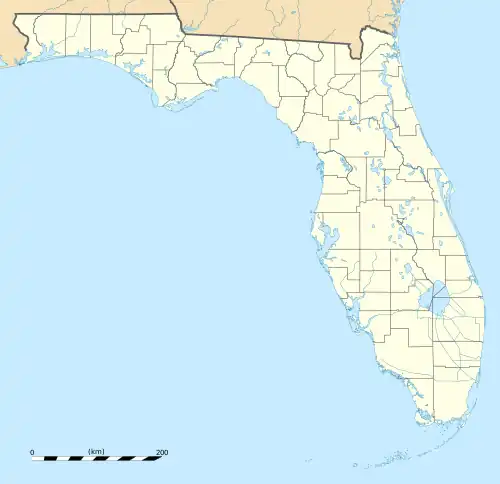Bulow Plantation Ruins Historic State Park | |
 Sugar mill ruins | |
  | |
| Location | Flagler County, Florida, USA |
|---|---|
| Nearest city | Bunnell, Florida |
| Coordinates | 29°26′10″N 81°08′28″W / 29.43611°N 81.14111°W |
| Area | 109 acres (44 ha) |
| Built | 1836 |
| NRHP reference No. | 70000185[1] |
| Added to NRHP | 29 September 1970 |
Bulow Plantation Ruins Historic State Park is a Florida State Park in Flagler Beach, Florida. It is three miles west of Flagler Beach on CR 2001, south of SR 100, and contains the ruins of an ante-bellum plantation and its sugar mill, built of coquina, a fossiliferous sedimentary rock composed of shells. It was the largest plantation in East Florida, and was operated with the forced labor of enslaved Africans and African Americans.[2]
History
The plantation was developed beginning in 1821 by Major Charles Wilhelm Bulow, who acquired 4,675 acres on a tidal creek (later Bulow Creek). He had 2,200 acres cleared by the labor of his enslaved workforce for the cultivation of commodity crops: indigo, cotton, rice, and sugarcane. At his death in 1823, his seventeen-year-old son, John Joachim Bulow inherited the property and managed it. At Christmas 1831 into January 1832, Bulow hosted the artist and naturalist John James Audubon, who explored the area in his continuing study of American birds.[2][3] About that time, Bulow had a sugar mill constructed on his property. The plantation was destroyed in the Seminole War of 1836.[2]
The property and ruins were acquired by the State of Florida in 1945 and dedicated as a State Historic Park in 1957. It was added to the National Register of Historic Places on 29 September 1970.[2]
Fauna
Among the wildlife of the park are bald eagles, swallow-tailed kites, and Florida manatees.
Recreational activities
Activities include hiking, fishing, wildlife viewing, canoeing and kayaking, and picnicking. Amenities include a 6.8 mile hiking trail, a boat ramp, and a screened picnic pavilion. Bulow Creek is recognized as a State Canoe Trail. The park's interpretive center features original artifacts and exhibits about the Bulow Plantation.[4]
Hours
The park is open between 9:00 AM and 5:00 PM Thursday through Monday. Bulow Plantation Ruins Historic State Park is closed on Tuesdays and Wednesdays.
Gallery
References
- ↑ "National Register Information System – Bulow Plantation Ruins Historic State Park (#70000185)". National Register of Historic Places. National Park Service. July 9, 2010.
- 1 2 3 4 "Dedication ceremonies for Bulow Plantation Ruins Historic State Park - Bunnell, Florida". floridamemory.com. Florida Memory Project. Retrieved November 13, 2011.
- ↑ Audubon, Lucy, ed. (1869). The Life of John James Audubon.
- ↑ "Bulow Plantation Ruins Historic State Park". Florida State Parks. Archived from the original on November 27, 2011. Retrieved November 13, 2011. New website: "Bulow Plantation Ruins Historic State Park". Florida State Parks.
External links
- Bulow Plantation Ruins Historic State Park at Florida State Parks
- Bulow Plantation Ruins State Historic Site at Absolutely Florida
- Hubbard, Committee of Claims (January 22, 1839). "Document No. 129: Report to accompany Senate bill No. 231". Public Documents Printed by the Order of the United States Senate, Third Session of the Twenty-fifth Congress. Vol. II (Containing Documents No. 18 to No. 146. Washington, DC: Blair and Rives. pp. 127–9.






